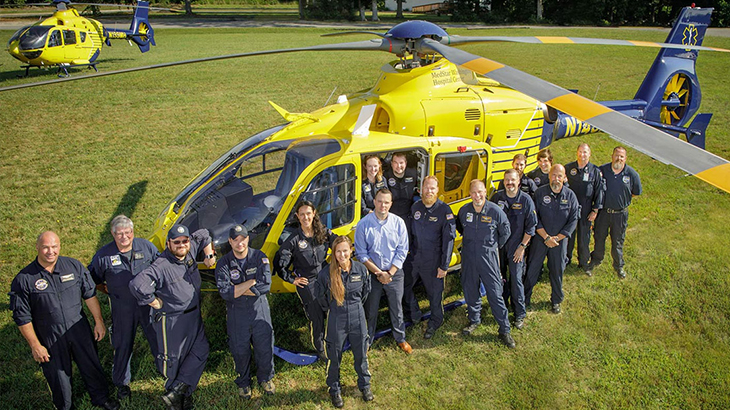
Expert emergency medical transport is just a call away
MedSTAR Transport about 6,000 patients each year to and from MedStar Health facilities throughout the Baltimore and greater Washington, D.C., area. Our fleet includes both state-of-the-art medevac helicopters and ambulances. And thanks to our highly qualified air and ground transportation teams, no patient is far from advanced care.
The majority of our patients are transported between hospitals in the MedStar Health system and other major tertiary care centers in the Mid-Atlantic region as directed by the sending and receiving physicians. Medical control physicians are immediately available 24 hours a day for consultation with referring physicians and flight crews. Some patients are transported from accident scenes to the closest Level One Trauma Center in coordination with local EMS systems.
During transport, our specialized team can initiate or continue critical care via our current evidence-based treatment protocols in any setting and have immediate access to critical care physicians. Our teams routinely manage patients on advanced mechanical ventilation modes including high flow nasal oxygen and APRV, Intra-Aortic Balloon Pumps, Ventricular Assist Devices, Impellas, ECMO, and many more advanced therapies.
Air transportation
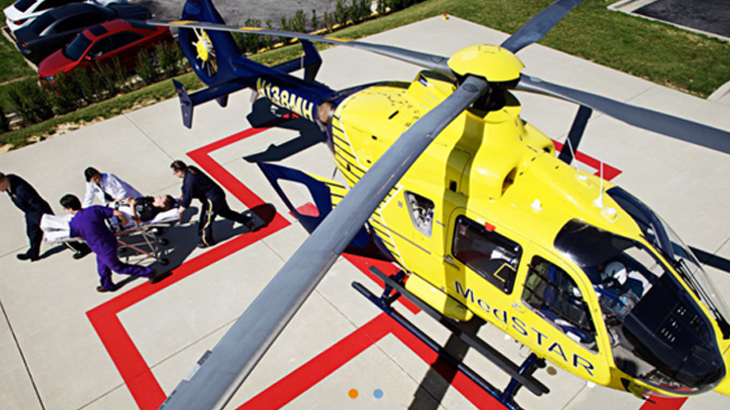
Our helicopter bases are strategically located throughout the mid-Atlantic region to transport patients and currently complete about 2,000 medevac missions a year.
All FAA Part 135 aviation services are provided by Metro Aviation, Inc., which maintains exclusive operational control over all aircraft. Our air transport service uses EC-135 helicopters, which are unmatched in maneuverability and have a cruising speed of 150 mph and a range of approximately 250 miles.
Each of the MedSTAR aircraft is equipped for single pilot operations under instrument flight rules (SPIFR) and are certified by the FAA for instrument flight in inclement weather using global positioning system (GPS) technology for increased safety. Additionally, all primary aircraft have SkyConnect Iridium-based satellite voice and tracking systems installed.
Our team also participates in Project Safeguard with Automatic Dependent Surveillance - Broadcast (ADS-B) equipment installed, which provides enhanced airspace security capabilities in the national capital region.
Ground transportation
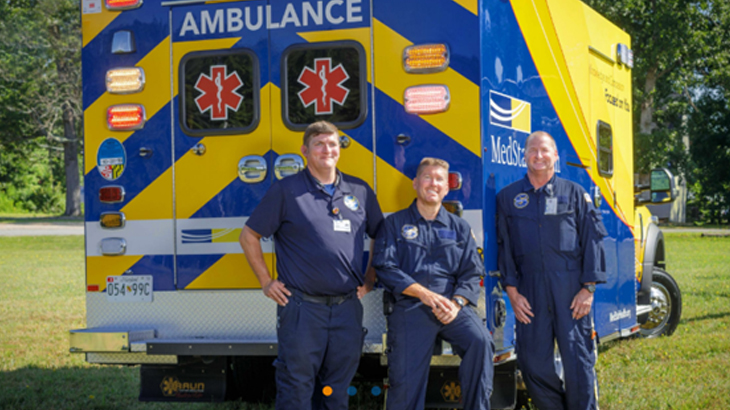
The ground division provides nurse-attended critical care and paramedic attended advanced life support (ALS) transports. We also contract to provide advanced life support, basic life support, and wheelchair van services into or out of any MedStar Health facility.
Additionally, the ambulance is configured to move bariatric and neonatal populations with ease and comfort.
Public relations and outreach requests
MedStar Transport supports community outreach events that meet the following criteria:
- Located in a safe and appropriate location with a secured landing zone/parking space, including fire department support to secure landing zones.
- Located within the primary service area of our health system.
- The ability for vehicle and crew to depart immediately if requested for a patient transport.
- Event hours are between 8 AM and 8 PM
- Event duration preferred to be less than two hours, though exceptions may be made for special circumstances (please note relevant details in the submission form).
- Only one helicopter may be committed to an outreach event at any time.
- All requests for appearances should be made at least 30 days prior to the event to allow sufficient time for planning and preparation.
All requests are subject to approval by the MedStar Transport leadership team.
Our team
Air transport teams
The standard flight crew includes a pilot, critical care nurse, and critical care paramedic, all of whom are trained to handle the full spectrum of adult and pediatric critical care patients.
The medical crew are required to maintain licensure with the District of Columbia and Maryland.
Our pilots are required to be helicopter-instrument-rated and have a Class 2 medical certificate, as well as a minimum of:
-
2,000 total flight hours
-
1,500 helicopter flight hours
-
1,000 helicopter hours as pilot in command (PIC)
-
100 hours of unaided night-flight time as PIC
-
500 hours of turbine time
Ground transport teams
The Critical Care Ground teams consist of an emergency vehicle operator, critical care nurse, and a critical care paramedic. Advanced Life Support teams consist of an emergency vehicle operator and paramedic. All crews have and maintain comprehensive training and experience to handle the full spectrum of adult and pediatric critical care patients.
Administrative team
Our administrative team includes the following:
-
Krista Wall, MHA – VP and Program Director
-
Gene McCutcheon, BSN, RN, CEN, CFRN – AVP of Clinical Operations
-
Lorelei Stellwag, DNP, RN, NE-BC – AVP, MedStar Capacity and Transfer Center
-
J. Matthew Sasser, MD – Medical Director
-
Jonathan Siegel, MBA, NRP, FPC – Flight Operations Manager
-
Ron Armontrout, NRP, FPC – Ground Operations Manager
-
Kayla Lynch, RN-BSN, CCRN, CFRN, PHN, NREMT-B – Director of Nursing and Interprofessional Development
-
Landra Bass-Price - Business Manager
-
Nicholas Wood - Applications Analyst III
-
Rick Dressler - Aviation Site Manager, Metro Aviation, Inc.
-
Bryan Nelson - Lead Maintenance Technician, Metro Aviation, Inc.
If you’re interested in joining our team, explore our career opportunities.
Program licensure and accreditation
- MedSTAR Transport is a licensed commercial EMS provider by the Maryland Institute of Emergency Medical Services Systems – License #000201.
- MedSTAR Transport is also authorized by the District of Columbia Health Emergency Preparedness and Response Administration (HEPRA) as an agency to provide ground transport, air transport, and special events – Agency #1008.
- MedSTAR Transport is proud to be accredited by the Commission on the Accreditation of Medical Transport Services (CAMTS) to provide ground, rotor wing, and neonatal intensive care unit (NICU) transport services.
Our service areas
We have three bases located in the Baltimore and Washington, D.C., regions, which are strategically located to provide support to patients in Maryland, Virginia, West Virginia, Delaware, and Pennsylvania.
These bases operate and are staffed 24 hours a day, seven days a week.
MedSTAR 1 - Tipton, Maryland Base
7501 General Aviation Drive, Suite 2
Fort Meade, MD 20755
P: 410-305-0186
F: 410-305-0184
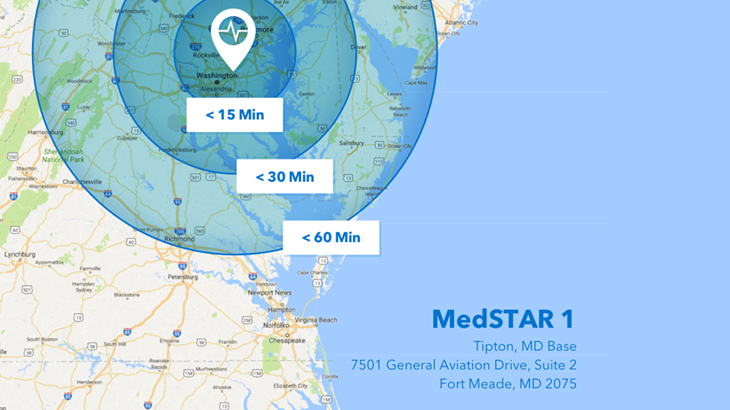
MedSTAR 2 - Indian Head, Maryland Base
3900 Livingston Road
Indian Head, MD 20640
P: 301-375-9442
F: 301-375-9441
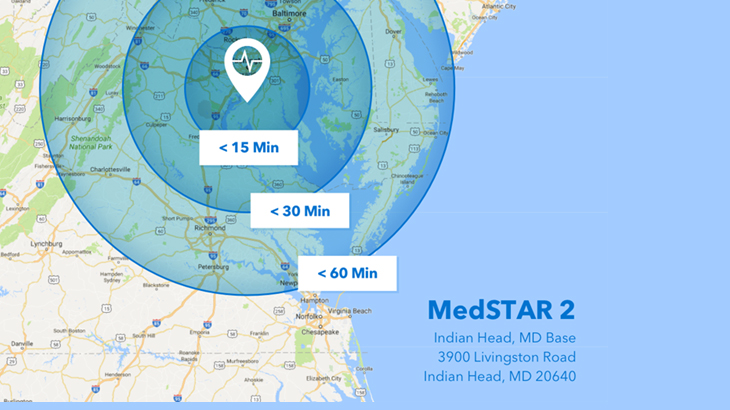
MedSTAR 3 - St. Mary's, Maryland Base
St. Mary's Airport
44170 Airport Road
Hollywood, MD 20636
P: 202-465-5112
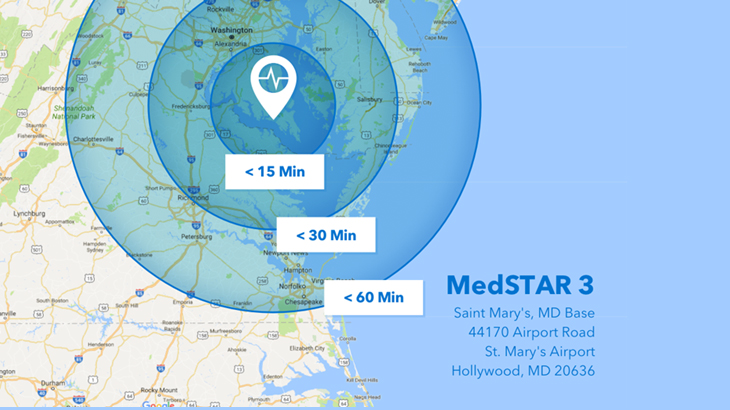
Landing zone requirements
Our team is available to land at a landing zone prepared by emergency medical services for both medical and trauma-related requests.
-
Our needs for a landing zone:
- 75 x 75 feet for day operations
- 100 x 100 feet for night operations
-
The area should be:
- Free of wires, debris, dust, and obstacles
- Flat and as smooth as possible
- Sloping terrain should be less than six degrees
- Clear of snow and ice (Do not use chemicals or salt to achieve this)
- If the area is dusty, please wet down first
-
Undesirable landing zone conditions include:
- An area with lots of trees, wires, debris, and obstructions
- An area too small or steep sloping terrain features
- An area where vertical take-off and landing are required
-
Daytime marking:
- Orange cones
- Emergency flares
- Strobes
- Construction or marking paint
-
Night operations needs:
- Lighted cones can be used
- Corner light from and landing zone kit can be used
- Vehicles with low-beam headlights can be used to light the landing zone
- Use spot lamps to illuminate hazards; no lights should point directly at the helicopter
- Flashing emergency lights aid pilot and crew in finding the landing zone at night, but you may be asked to turn them off as the helicopter approaches
-
Other important information:
- All crew members wear Night Vision Goggles (NVG) at night
- NVGs amplify light 6,000 times
- NVGs do not allow us to change our weather minimums and do not allow us to see through fog, clouds, heavy rain, or snow
-
Main rotor safety
- Never approach the aircraft without a crew member
-
Tail rotor safety
- The EC-135 is equipped with an enclosed tail rotor
- The tail rotor is also known as a fenestron tail rotor. This works like a ducted fan. High winds are possible during operation
- Never go aft of the horizontal stabilizer of the aircraft when the tail rotor is turning. SERIOUS INJURY OR DEATH CAN OCCUR!
Our history and milestones
MedSTAR fleet was the Washington, D.C., region’s first hospital-based air medical service. It was founded to deliver critical care to injured patients, much like a MASH unit used for military triage.
Learn more about our history and achievements through the decades:
-
1960s
1963
Three seriously injured patients are transported by police helicopter to MedStar Washington Hospital Center. This is the first time patients arrive at that centerby air for medical treatment.
-
1970s
1974
MedStar Washington Hospital Center installed its first helipad for air ambulance transport, a project underwritten by the Women’s Auxiliary.
1979
Several years in planning, MedSTAR (Medical Shock Trauma Acute Resuscitation) opened on the first floor of MedStar Washington Hospital Center’s Intensive Care Tower. The new $1.6 million unit includes a helipad, seven resuscitation rooms, one full-service operation room, and a communications center. On March 12, the unit received its first patients.
-
1980s
1983
MedStar Washington Hospital Center purchased its first twin-jet helicopter and established MedSTAR Transport. The first official flight took off on July 3, 1983 to fly a spinal-cord injury patient from Prince William County, Virginia to MedStar Washington Hospital Center. Pictured below, Wade Smith who was on the first flight and is still with us today!
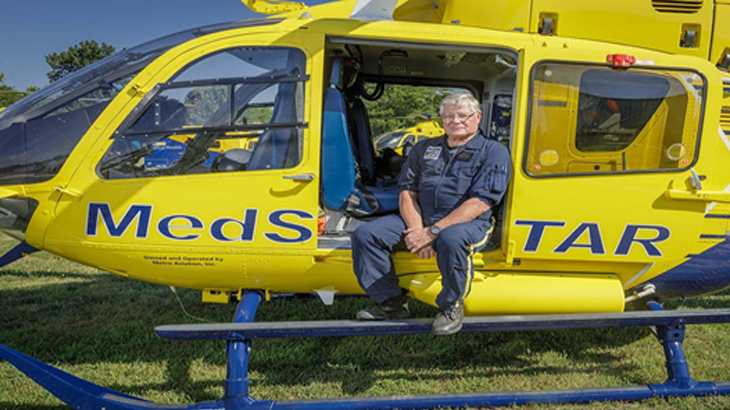
-
1990s
1990
We flew more than 1,600 patients this year.
1992
We celebrated 10 years with a flawless safety record. The program was granted independent status from MedSTAR Trauma, placed within the Department of Emergency Medicine with the support of the Division of Surgical Nursing.
1993
Approaching its 15th anniversary, MedSTAR was consistently named one of the country’s top 10 Level 1 Shock-Trauma units. MedSTAR Transport carried more than 3,000 critically injured or ill patients to MedStar Washington Hospital Center each year.
1996
MedSTAR leased two BK117 Helicopters based out of MedStar Washington Hospital Center, one operated 24/7 and the second 12/7
1999
MedSTAR Transport starts its dedicated ground critical care transport services based out of MedStar Washington Hospital Center using a leased ambulance. This year MedSTAR also out-based its first helicopter base at Maryland Airport (2W5).
-
2000s
2000
MedStar Washington Hospital Center purchased a EC-135, a single pilot instrument flight rules (SPIFR) helicopter, the first SPIFR-certified EC-135 to operate in the United States. The aircraft is able to fly in inclement weather, using GPS technology for more accurate maneuvering. MedSTAR Transport becomes the clearinghouse for referrals, flight operations and coordinating ambulances for MedStar Washington Hospital Center. This year we handled 1,700 patients.
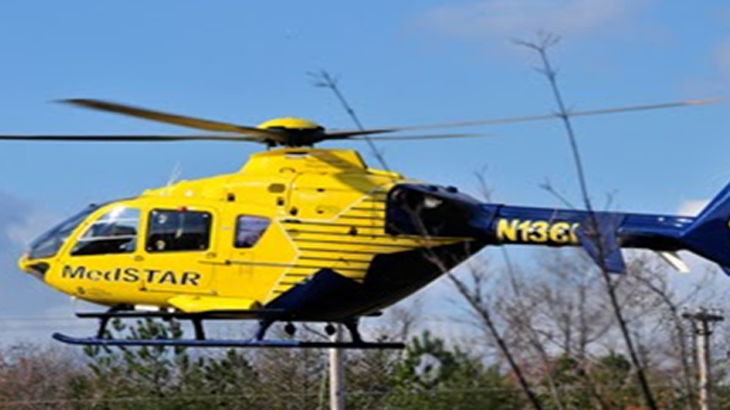
2001
On September 11, MedStar Washington Hospital Center called a Code Orange for mass casualty readiness as it prepared to receive the injured from the terrorist attack on the Pentagon. Dispatched within minutes of the incident, our helicopters were among the first medevac helicopters to arrive at the scene. This year, the service also had two ground ambulances. More than 2,000 patients were flown this year by MedSTAR Transport.
2002
MedSTAR Transport added another helicopter and three more ground ambulances to its stable. The service flew more than 3,000 patients this year.
2003
MedSTAR Transport celebrated 20 accident-free years of service to the community. The service has made almost 40,000 flights since it began in 1983.
2004
MedSTAR obtains D.C. Commercial Ground Ambulance via Certificate of Need process. The State of Maryland approves COMAR for licensing of Commercial Air Ambulance providers.
2005
MedSTAR obtains initial Maryland commercial air ambulance license and signs a memorandum of understanding with the state of Maryland to provide helicopter medevac from accident scenes. MedSTAR also signed an Air Ambulance agreement with the state of Delaware.
2006
MedSTAR Transport opened a state-of-the-art communications center in October in Lanham, Maryland.
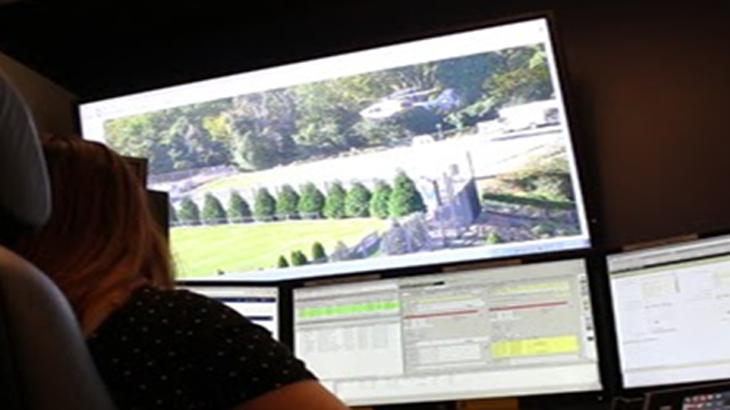
2008
MedSTAR celebrates 25 years of service.
-
2010s
2015
D.C. completes regulations on licensing commercial air ambulances and MedSTAR receives its first D.C. Air Ambulance License.
2017
MedSTAR expands ground critical care services to the Baltimore region by opening a base at MedStar Health - Harbor Hospital
How to contact the Department of Transportation
The FAA Reauthorization Act of 2018 requires Air Ambulance Providers to include the hotline telephone number (202-366-2220), website address, and contact information (Aviation Consumer Protection Division, C-75, US Department of Transportation, 1200 New Jersey Ave, SE, Washington, D.C., 20590)









